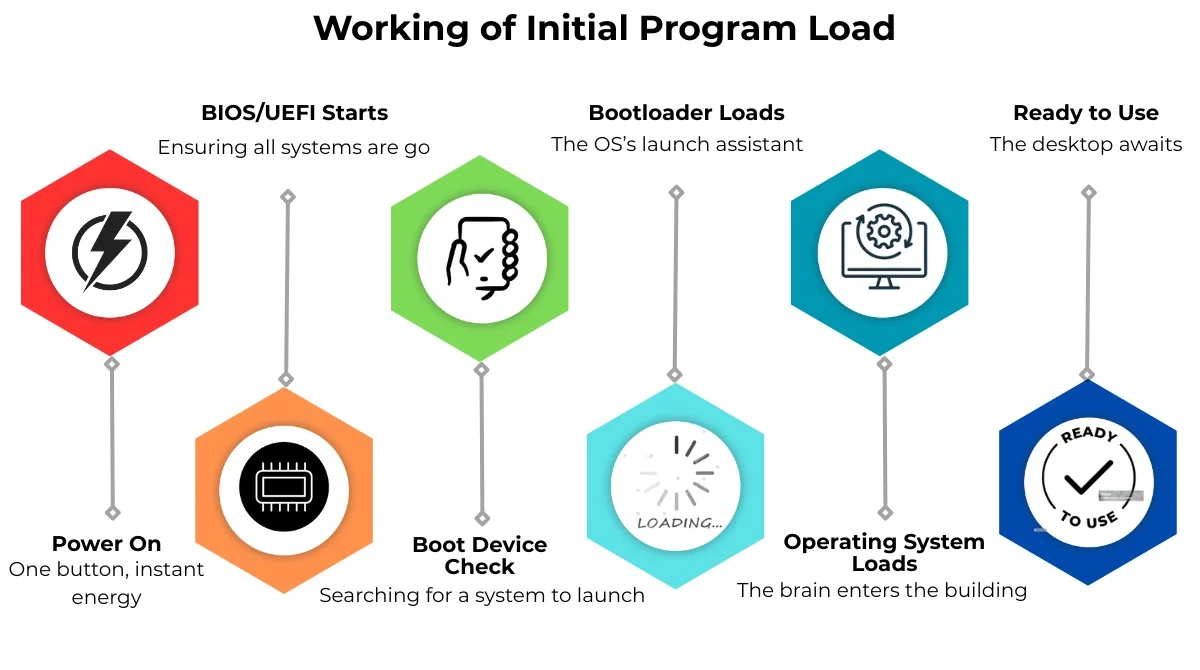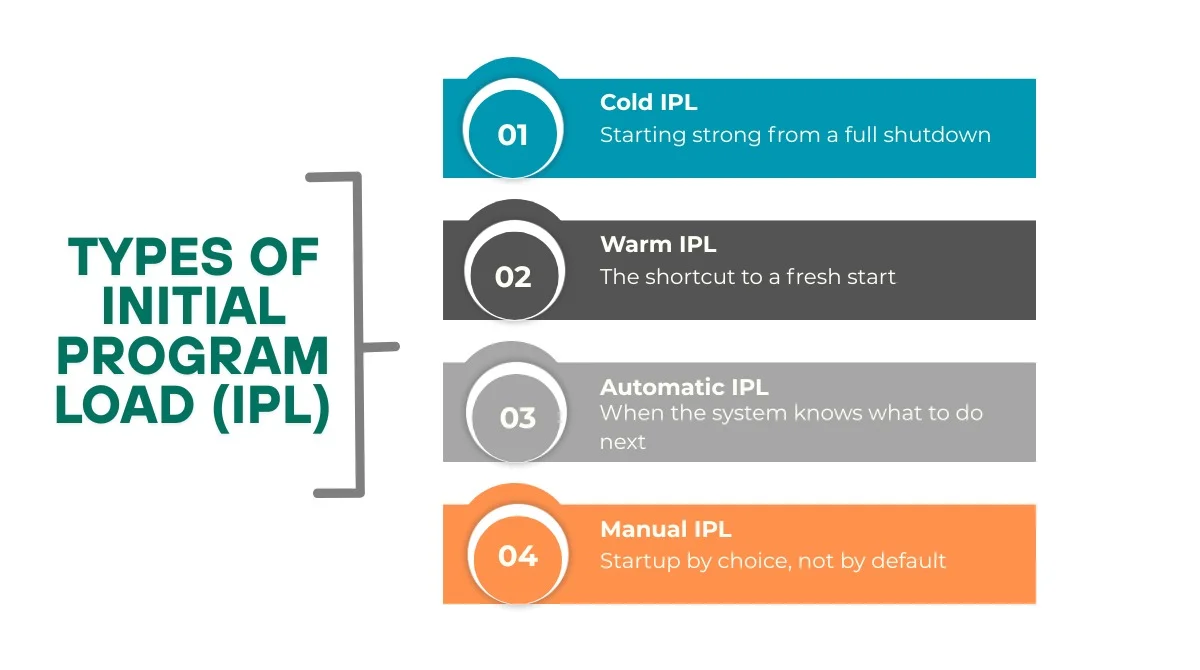Initial Program Load (IPL) is the process a computer follows to load the operating system into memory when you turn it on. For example, when you press the power button on your computer, the system runs checks, loads basic settings, and prepares everything before the desktop appears. IPL is like your morning routine getting everything ready before starting the day. Without it, the system wouldn’t know how to start or what to load.
How Does Initial Program Load Work?

Think of a computer starting up like a person waking up and getting ready. It follows several steps before it’s ready to work:
- Power On: Pressing the power button sends electricity to the system like waking up.
- BIOS/UEFI Starts: These are small programs that check if your keyboard, screen, memory, and drives are working.
- Boot Device Check: BIOS or UEFI looks for a storage device (like a hard drive or USB) that has the operating system.
- Bootloader Loads: A small helper program is loaded to begin the OS startup.
- Operating System Loads: The main system (like Windows or Linux) loads into memory.
- Ready to Use: You see the login screen or desktop your system is now ready.
Together, these swift actions form the Initial Program Load. Though it happens in seconds, it’s crucial for your computer to function properly.
Why Is IPL Important?
Even though IPL runs automatically, it plays a vital role in system startup:
- Starts the Computer: Like starting a car’s engine, IPL is what gets the system running.
- Checks Hardware: It ensures all parts like the keyboard, RAM, and storage are working. If something’s wrong, it shows an error.
- Sets Boot Order: You can choose which device the system loads from useful for installing or repairing software.
- Aids Troubleshooting: Knowing how IPL works helps identify startup problems, whether hardware or software.
- Critical for Servers: In large systems like servers or mainframes, IPL is carefully managed because a failure can affect many users.
Without IPL, no device could start properly or safely.
IPL in Modern Computers
Originally, IPL was a term mainly used for mainframe systems like IBM’s, where loading programs needed strict control. Today, most people simply call it booting up.
Modern computers have made IPL much faster, thanks to SSDs, NVMe drives, and powerful processors. On most systems, it takes just a few seconds.
Features like Fast Boot and Secure Boot built into UEFI help speed up startup and protect against malware, making the process quicker and safer.
What Happens If IPL Fails?
Sometimes, the Initial Program Load does not complete successfully. When this happens, your system may:
- Show a black screen with an error message
- Display messages like “No bootable device found”
- Make beeping sounds from the motherboard speaker
- Stay stuck on the logo screen
These indicators suggest that an error occurred during the Initial Program Load (IPL). It could be because the hard drive is not connected properly, the bootloader is corrupted, or the operating system files are damaged.
In such cases, you might need to:
- Enter BIOS/UEFI and check if your hard drive is being detected
- Change the boot order
- Utilize a recovery USB drive or DVD to repair corrupted system files.
- Reinstall the operating system if needed
Knowing the basics of IPL can help you understand what steps to take when your system doesn’t boot correctly.
Types of Initial Program Load (IPL)

There are different types of IPL based on how the system starts and what triggers it. These are especially important in enterprise systems like servers and mainframes, but they also apply in simpler ways to personal computers.
1. Cold IPL
This is a full start from complete power-off. All hardware checks are done, settings are loaded fresh, and the system starts from scratch.
Example: Turning on your computer after it’s been shut down overnight.
2. Warm IPL
In a warm IPL, the system restarts without completely cutting power. It skips some hardware checks to save time.
Example: Restarting your computer without shutting it down fully.
3. Automatic IPL
Some systems can perform an IPL automatically after a power failure or crash, using pre-set instructions.
Example: A server restarting itself after a power outage.
4. Manual IPL
This requires a user or administrator to start the system manually, often with custom settings or from a specific device.
Example: Booting from a USB to install or repair the operating system.
IPL vs Booting
Sometimes, people ask: “Is IPL the same as booting?” The two are closely related, though not entirely identical.
- IPL is the whole process of loading the initial program into the memory from the moment you power on the machine.
- Booting is a part of IPL, specifically the part where the operating system starts loading.
To put it simply, booting represents one phase of the IPL process.
IPL in Mobile Devices and Embedded Systems
You might be surprised to know that something similar to IPL happens even in your smartphone or tablet. While we don’t usually call it IPL in mobile devices, the process is pretty much the same.
Upon pressing the phone’s power button:
- A small piece of software called the bootloader starts
- It loads the Android or iOS operating system
- Then the phone becomes ready for use
In embedded systems like smart TVs, washing machines with digital displays, or routers there is also an IPL-like process. These devices need to load small operating systems to function properly, and they go through their version of IPL when powered on.
Conclusion
Initial Program Load (IPL) may sound technical, but it happens every time you turn on a device whether a PC, phone, or server. IPL loads the operating system and prepares your system for use. Understanding IPL helps you troubleshoot startup issues and make smarter decisions when managing your devices. So, next time you see your device’s logo, remember that a crucial process is working behind the scenes to get it ready for you.



